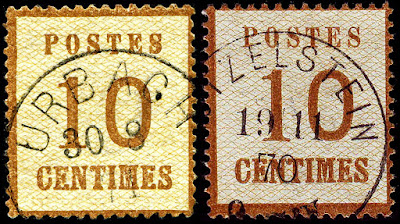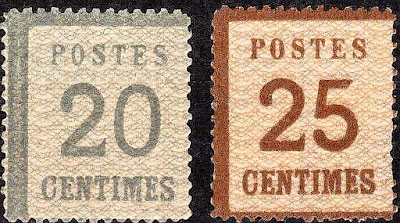A Short History
German troops occupied Alsace & Lorraine and parts of Northern France in August 1870.
The Alsace-Lorraine issue of 1870 was prepared as an emergency issue for the civilian post in occupied territories . The stamps were type-set for speed of production and printed at the Berlin Reichsdruckerei (State Printing Works) , and issued in colours similar to those in use in France (except for the 25c).
German troops occupied Alsace & Lorraine and parts of Northern France in August 1870.
The Alsace-Lorraine issue of 1870 was prepared as an emergency issue for the civilian post in occupied territories . The stamps were type-set for speed of production and printed at the Berlin Reichsdruckerei (State Printing Works) , and issued in colours similar to those in use in France (except for the 25c).
The burelage under-print was printed to deter forgery. The appearance of the under-print is that of a net, with points facing either up or down.
First printings appear to have been made with points up or down at random; later printings were with points up.
Genuine stamps are therefore scarcer with points down
 |
| Burelage points up & down |
Following the armistice , Alsace & Lorraine was ceded to the Northern German Confederation , and other occupied areas restored to France.
Use of Alsace stamps ended on 24th March 1871 in the restored territories , but continued until the 31st of December 1871 in Alsace & Lorraine, after which eagle stamps of the new German Empire came into use.
As the stamps were type-set and there are 4 sets of 150 stamps per plate, theoretically, 600 varieties of each denomination exist.
Luckily the State Printing Works (Reichsdruckerei) were accurate enough that most can be grouped into just a few “varieties” for each denomination.
Some varieties like the 20c which is 3.5mm above the “CENTIMES” instead of 2mm is extremely rare and only a few copies exist.
Of note, the printing apparently used a special security paper that has an invisible under-print of lead monoxide carbonate. Older texts on the subject note that exposure to certain chemicals makes the network show up in brown but unfortunately ruining the philatelic value of the stamp…
The perforation is 131/2X 141/4 with a tip to tip measurement of about 23.5mm. There are normally 14 horizontal and 17 vertical perforations.
However, there are misaligned stamps of 23mm. and even some rarer ones 24.5-25mm with different numbers of perforations
A key feature of the genuine stamps is the M of CENTIMES which is slightly taller than the other letters.
The originals may also be separated into various types based on letter positions. This allows for further examination of genuine copies as well as the possible higher CV in some cases of rarity.
Rarely are these types mentioned on auction sites.
1c Types
 |
| left: grey green points up - right: olive green points down |
2c - no types recorded
 |
| left: red brown points up - right: dark red brown points up |
4c Types
 |
| Left: violet grey TII points up - Right grey TII points down |
5c Types
 |
| Both Type I Left: yellow green pts up - right: light green points down |
10c Types
 |
| Left: dark ocher TI points up - Right med brown TII points down |
20c Types
 |
| Left: TII points up - Right: TI points up |
25c Types
 |
| Left: TI dk. brown points up - Right: TII dk. brown points down |
Forgeries
Two main sets of forgeries exist:
Those produced in Paris towards the end of the 19th century, and another set produced by Fournier (or at least sold by him).
Although the Paris forgeries were printed in two operations, the key characteristic is that the frame and net pattern were printed together in one stage, followed by the inscription and value.
The net pattern, therefore joins but does not cross the colored frame as it does with the originals. Apparently the Paris forgeries were also printed in Bruxelles , but if two printings exit , there is nothing to distinguish them from each other. The general quality of the Paris forgery is poor (blurred design , rough perfs etc).
Fournier’s forgery, on the contrary, is too crisp.
The network is thinner and sharper than the original , with more rounded points on the nets. The Paris forgery was derived from a reprint (therefore showing wide “POSTES” and points down) whereas Fournier’s inscription is copied from an original.
All the forgeries should be line perforated as the originals are comb perforated, this should help for identification.
This may by be difficult to see so look at the corners, forgeries tend to have missing or uneven corners.
This diagram may help.
 |
| Comb & Line perf comparisons |
Hamburg/Fournier Forgeries
These are by far the most common forgeries. They come in both Type I & II and generally with fake cancels.
Below Fournier forgeries as they appear in the 5 volume Geneva Collection.
One should bear in mind that most of the "Fournier" forgeries in the Geneva collection were not made by Fournier but only resold by him.
The simplest features to check are.
1. The points and wavy lines are very inconsistent in size and shape (see image below).
2. The stamps are lined perf instead of comb perf
3. The M is the same height as the other letters
4. Stamps line perfed instead of comb perfed
 |
| Genuine left - Fournier right |
Fournier examples with Cancels
 |
Left: typical and unusual URBEIS cancel (Feb. does not have 31 days) and Right Metz 30/6 71. |
 |
| 20c horseshoe cancel COLMAR 30 Aug 71 10-11V and 25c with Egisheim 13 2 71 2-3 N |
Some interesting possible trial prints found in the Geneva collection.
The blue diagonal lines are imprints by Geneva on the forgery nature of the stamps.
Paris/Bruxelles Forgeries
These forgeries are not common.
These forgeries are not common.
1. The tops of the M tend to be distorted and wider on the right side
2. The top part of the S of POSTES is not well rounded
3. The perfs tend to be rough and are line perfed
4. The bottom right of the N bends slightly left
5. They all appear to be badly centered
6. There are no corner breaks
7. They tend to be points down
8. They have a duller appearance
Reprints
In 1885 a Hamburg dealer named Wiering ordered a very large quantity of “reprints” from the Reichsdruckerei for the generous sum of 7000 marks to be deposited to the employees fund.
A large part of the consignment was later marketed by the dealer Goldner, so the stamps are often known as Goldner reprints .
Only the plates for the “net” points down remained at the Reichsdruckerei, so the border and value were reset .
All reprints have points facing downwards except for 1 very rare sheet of 150 1c stamps
Most often cited as a quick sure fire method of checking originals and reprints is by placing a line from top left to bottom right corner inside the frame.
In the originals the line will touch the base serif of the letter P and in the reprints the line will cross nearer the center of the letter P. This is due to the word POSTES being wider in the "reprints". This test is not guaranteed according to some experts but I have not seen any different examples
Generally “reprints” are unused stamps but some may have Fournier cancels on them.
In any event these are not “reprints” since new plates were made, in my opinion, they are imitations/forgeries in their own rights.
As these fakes were made in 1885, they are very common and present in most if not all old collection.
Other Characteristics of “reprints” vs. originals
1. The length of the word POSTES is 11 mm to 12.5 mm for the original, 12.5 mm to 13 mm for the reprint
2. The distance of the word POSTES to the left margin is 3 mm to 3 ½ mm, for the original, under 2.8 mm for the fake.
3. The height of the image is larger than 21.4 mm for the original
4. The vertical perforations for the genuine are 14.25, reprint 14.5.
5. They also do not have the special security paper.
6. As the ones with tips pointing down (Type II) are more scarce and the reprints are only Type II, there is a good chance that most Type II will be the reprints.
There was one sheet of reprints in type I found and it is very valuable and not in circulation.
7. The M is the same height as the other letters
Reprint examples


























Easily the most helpful tool for identifying forgeries(or reprints) I've seen. Thanks!
ReplyDeleteThank You - the goal is to present a little history and the features of the forgeries with hopefully quality images. Unfortunately so many of the great works from the early 1900's were lacking in many areas.
Delete